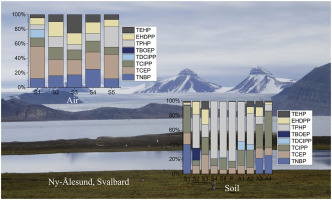当前位置:
X-MOL 学术
›
Environ. Pollut.
›
论文详情
Our official English website, www.x-mol.net, welcomes your
feedback! (Note: you will need to create a separate account there.)
Occurrence and distribution of organophosphate esters in the air and soils of Ny-Ålesund and London Island, Svalbard, Arctic.
Environmental Pollution ( IF 7.6 ) Pub Date : 2020-04-03 , DOI: 10.1016/j.envpol.2020.114495 Xu Han 1 , Yanfen Hao 1 , Yingming Li 2 , Ruiqiang Yang 2 , Pu Wang 2 , Gaoxin Zhang 2 , Qinghua Zhang 1 , Guibin Jiang 1
Environmental Pollution ( IF 7.6 ) Pub Date : 2020-04-03 , DOI: 10.1016/j.envpol.2020.114495 Xu Han 1 , Yanfen Hao 1 , Yingming Li 2 , Ruiqiang Yang 2 , Pu Wang 2 , Gaoxin Zhang 2 , Qinghua Zhang 1 , Guibin Jiang 1
Affiliation

|
The levels of eight organophosphate esters (OPEs) were analyzed in air and soil samples collected at Ny-Ålesund and London Island, Svalbard during the Chinese Scientific Research Expedition to the Arctic during 2014-2015. The concentrations of total OPEs (∑OPEs) ranged from 357 pg/m3 to 852 pg/m3 in the air and from 1.33 ng/g to 17.5 ng/g dry weight (dw) in the soils. Non-Cl OPEs accounted for 56 ± 13% and 62 ± 16% of ∑OPEs for the air and soil, respectively. Tris(2-chloroethyl) phosphate (TCEP) was the dominant compound in the air, with an average concentration of 180 ± 122 pg/m3. Triphenyl phosphate, tri(1-chloro-2-propyl) phosphate, and TCEP were the most abundant OPEs in the soils, with mean values of 1.77, 2.13, and 1.02 ng/g dw, respectively. Compared with the levels of polybrominated diphenyl ethers found in Arctic regions in previous studies, OPEs showed significantly higher concentrations, thereby indicating the large production and wide usage of OPEs globally. In addition, the fugacity fraction results indicated that net deposition from air to soil was dominated in the area. Overall, the occurrence and distribution of OPEs in the air and soils in the Arctic region indicated that OPEs can undergo long-range atmospheric transport and accumulate in remote regions.
更新日期:2020-04-03









































 京公网安备 11010802027423号
京公网安备 11010802027423号